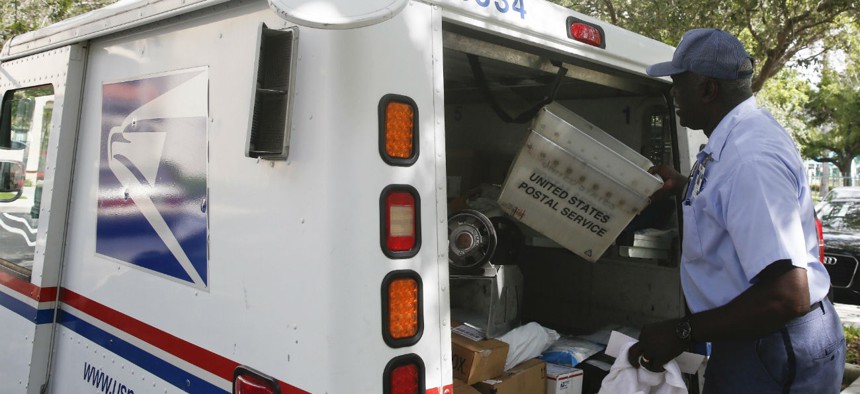
Brynn Anderson / AP
Postal Service Doubles Annual Losses to $8.8 Billion
USPS is no longer seeing accelerating growth from its shipping and package business.
The U.S. Postal Service lost $8.8 billion in fiscal 2019, more than doubling its losses from the previous year.
The results marked the 13th consecutive year the mailing agency lost money, although USPS did post a slight uptick in revenue to $71.3 billion. A precipitous decrease in mail usage continued to wreak havoc on the Postal Service’s finances, with overall volume dropping by 3.8 billion pieces.
Postal management suggested the spike in its losses over fiscal 2018 was not as dramatic as it appears at first glance. After controlling for an adjustment to interest rates paid for workers’ compensation, losses this past fiscal year were $6.7 billion compared to $5.3 billion the previous year. USPS also took $7.3 billion onto its books for payments into its retiree pension fund and to prefund health benefits for future retirees, though it failed to actually make those payments due to its precarious financial situation. The Postal Service is seeking changes to its statutory requirements for those payments to give it more operational flexibility.
Still, the agency’s losses on the parts of its business that management can control also spiked to $3.4 billion, a 70% increase from fiscal 2018. USPS has increasingly relied on growth to its shipping and package revenue—which now accounts for one-third of its business—to make up for losses from regular mail, but volumes from even that sector are no longer accelerating at the same rate. Shipping revenue was up only 6% on the year, and actually declined in each of the last two quarters compared to the same periods a year earlier.
Postmaster General Megan Brennan on Thursday attributed the slow down to increasing competition. She noted management is continuing to make adjustments and cut costs, but reiterated her ongoing plea for Congress to provide reforms and for the agency’s regulators to give the USPS governing board more freedom to set prices.
"However, revenue growth in our package business will never be enough to offset imbalances in the Postal Service's business model, which must be addressed through legislative and regulatory reforms in order to secure a sustainable future," Brennan said.
USPS cut 4.3 million work hours in the last three quarters of fiscal 2019 through attrition and a reduction in overtime. Spending on salaries and benefits still increased by $1 billion, or 2%, and overall expenses jumped by $1.9 billion. The agency paid off $2.2 billion in debt during the year, but still has $11 billion outstanding.
The Postal Service recently issued its largest-ever increase in the price of a stamp, but is currently fighting a legal battle to ensure its implementation.
Fredric Rolando, president of the National Association of Letter Carriers, said the increase in revenue actually demonstrated a “solid performance” by the Postal Service.
“What the overall results indicate is a need to address public policy flaws, through targeted regulatory and legislative reforms,” Rolando said, “while avoiding drastic measures that would hurt Americans and their businesses.”







